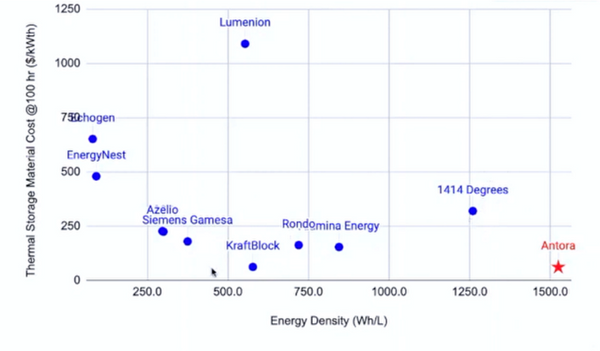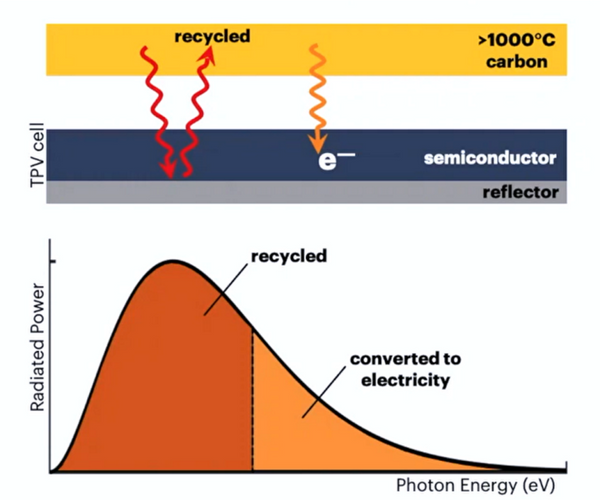In 2022, Antora Energy, a start-up in the field of long-term energy storage, received a $50 million financing co-led by Bill Gates’ Breakthrough Energy Ventures and venture capitalist Chris Sacca’s Lowercarbon Capital. The investment department also participated in this investment. It is also the largest funding round in the field since EnergyNest raised $130 million for a similar concrete-based technology last April. This article will explore why this energy storage start-up company, which originated in Silicon Valley and was established in 2018, is favored by many investors.
1. The development background of Antora Energy
Antora Energy was founded by three young people from MIT and Stanford University, Andrew Ponec, Justin Briggs, and David Bierma, with the goal of using low-cost high-temperature thermal energy storage (solid carbon blocks) and high-efficiency TPVs (Thermophotovoltaic) To solve the intermittent challenges of wind and solar energy to the grid, while solving the cost economy of traditional energy storage.
Soon after the company was established, it was funded by the US Energy Agency ARPA-E (Advanced Research Projects Agency -Energy) in August 2018, and became the first batch of GameChanger Accelerators supported by the US National Renewable Laboratory NREL. E, CEC (California Energy Agency), NSF (National Science Foundation) and other agencies received about $24 million in funding

2. Introduction of Antora Energy's core technology
Antora Energy's positioning is to develop long-term energy storage to meet the problem of insufficient regulation caused by large-scale new energy access to the power grid in the future. Double the problem. Therefore, the company has broken the situation in three aspects. One is heat storage medium, looking for a heat storage medium with low cost and high energy density; the second is the method of heat transfer, looking for a simple and reliable heat conduction method; the third is thermoelectric conversion, looking for feasible heat -Electrical conversion technology. Through a large number of market research, technical analysis and demonstration, the technical solution shown in the figure below is finally adopted. The heat storage medium adopts carbon block, the heat transfer method adopts light radiation, and the power generation method adopts photothermal power generation.
(1) Inexpensive solid carbon block
Compared with other thermal energy storage products, Antora Energy uses solid carbon blocks as the thermal storage medium, which has the advantages of low cost, sufficient supply of raw materials, extremely high energy density, and high thermal conductivity.


(2) Efficient and reliable optical radiation
Temperatures up to 1500 degrees Celsius can be raised to 1500 degrees Celsius with low cost and high reliability using high-intensity aggregated light.
(3) Independent research and development of high-efficiency CSP technology
By recycling the low-energy light source multiple times as shown in the figure below, the thermoelectric conversion efficiency reaches 40% (currently the highest conversion efficiency in the world in this field).

 3. Introduction of product application
3. Introduction of product application
At present, Antora Energy's 500 kWh prototype is in the commissioning stage and has completed 1,000 hours of successful running tests. The first demonstration projects will be completed and put into production in Fresno, California in 2022.
4. Strengths and weaknesses of Antora Energy
Advantages: Antora Energy can significantly reduce the cost of products through low-cost solid carbon block heat storage and solar thermal power generation.
Disadvantages: Compared with other energy storage technologies, the thermoelectric efficiency still has a certain gap, and it is not economically feasible to simply use it for power supply and grid energy storage. The product application scenarios need to be further explored, which can be explored in combination with scenarios such as cogeneration of industrial parks.
V. Future Outlook
With the increasing scale of global new energy, the role of long-term energy storage will become increasingly prominent, and the market demand for long-term energy storage represented by thermal energy storage, physical energy storage and other forms of electrochemical energy storage will also usher in an explosion type of growth. However, a lot of work still needs to be done on the technical route, technical feasibility, technical and economic cost and market positioning of long-term energy storage.
At present, rapid technological advancement is being carried out for long-term energy storage technology. The plans and so on are all in full swing to carry out technology research and development and commercial deployment, and the number of various technologies is endless.

